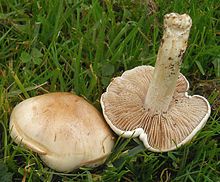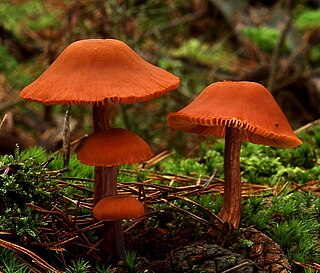
Laccaria laccata, commonly known as the deceiver, lackluster laccaria, or waxy laccaria, is a white-spored species of small edible mushroom found throughout North America and Europe. It is a highly variable mushroom, and can look quite washed out, colorless and drab, but when younger it often assumes red, pinkish brown, and orange tones. The species is often considered by mushroom collectors to be a 'mushroom weed' because of its abundance and plain stature.

Coprinus comatus, commonly known as the shaggy ink cap, lawyer's wig, or shaggy mane, is a common fungus often seen growing on lawns, along gravel roads and waste areas. The young fruit bodies first appear as white cylinders emerging from the ground, then the bell-shaped caps open out. The caps are white, and covered with scales—this is the origin of the common names of the fungus. The gills beneath the cap are white, then pink, then turn black and deliquesce ('melt') into a black liquid filled with spores. This mushroom is unusual because it will turn black and dissolve itself in a matter of hours after being picked or depositing spores.

Macrolepiota procera, the parasol mushroom, is a basidiomycete fungus with a large, prominent fruiting body resembling a parasol. It is a fairly common species on well-drained soils. It is found solitary or in groups and fairy rings in pastures and occasionally in woodland. Globally, it is widespread in temperate regions.

Coprinopsis atramentaria, commonly known as the common ink cap, tippler's bane, or inky cap, is an edible mushroom found in Europe and North America. Previously known as Coprinus atramentarius, it is the second best known ink cap and previous member of the genus Coprinus after C. comatus. It is a widespread and common fungus found throughout the northern hemisphere. Clumps of mushrooms arise after rain from spring to autumn, commonly in urban and disturbed habitats such as vacant lots and lawns, as well as grassy areas. The grey-brown cap is initially bell-shaped before opening, after which it flattens and disintegrates. The flesh is thin and the taste mild. It can be eaten, but due to the presence of coprine within the mushroom, it is poisonous when consumed with alcohol, as it heightens the body's sensitivity to ethanol in a similar manner to the anti-alcoholism drug disulfiram.

Chroogomphus vinicolor, commonly known as the wine-cap Chroogomphus or the pine spike, is a species of mushroom in the family Gomphidiaceae. Found in North America and the Dominican Republic, mushrooms grow on the ground under pine trees. Fruit bodies have reddish-brown, shiny caps atop tapered stems. The gills are thick, initially pale orange before turning blackish, and extend a short way down the length of the stem. Although the mushroom is edible, and sold in local markets in Mexico, it is not highly rated. Distinguishing this species from some other similar Chroogomphus species is difficult, as their morphology is similar, and cap coloration is too variable to be a reliable characteristic. C. vinicolor is differentiated from the European C. rutilus and the North American C. ochraceus by the thickness of its cystidial walls.
Hebeloma aminophilum, commonly known as the ghoul fungus, is a species of mushroom in the family Hymenogastraceae. Found in Western Australia, it gets its common name from the propensity of the fruiting bodies to spring out of decomposing animal remains. Its edibility is unknown.

Hebeloma sinapizans, commonly known as the rough-stalked hebeloma or the bitter poisonpie, is a species of mushroom in the family Hymenogastraceae. It has a strong radish-like smell, and a prominent bulbous stem base. It is larger than the similar and more common H. crustuliniforme, a relative that is also poisonous. H. sinapizans is found in Europe and North America.

Hebeloma radicosum, commonly known as the rooting poison pie, is a species of agaric fungus in the family Hymenogastraceae. Fruit bodies (mushrooms) can be identified by the tapering root-like stipe base, as well as the almond-like odor. Found in Japan, Europe, and North America, it is an ammonia fungus, and fruits on mole, mouse, or shrew middens.

Mycena overholtsii, commonly known as the snowbank fairy helmet or fuzzy foot, is a species of fungus in the family Mycenaceae. The mushrooms produced by the fungus are relatively large for the genus Mycena, with convex grayish caps up to 5 cm (2 in) in diameter and stems up to 15 cm (6 in) long. The gills on the underside of the cap are whitish to pale gray, and initially closely spaced before becoming well-spaced at maturity after the cap enlarges. The mushrooms are characterized by the dense covering of white "hairs" on the base of the stem. M. overholtsii is an example of a snowbank fungus, growing on well-decayed conifer logs near snowbanks, during or just after snowmelt. Formerly known only from high-elevation areas of western North America, particularly the Rocky Mountain and Cascade regions, it was reported for the first time in Japan in 2010. The edibility of the mushroom is unknown. M. overholtsii can be distinguished from other comparable species by differences in location, or spore size.

Agrocybe pediades is a typically lawn and other types of grassland mushroom, but can also grow on mulch containing horse manure. It was first described as Agaricus pediades by Swedish mycologist Elias Magnus Fries in 1821, and moved to its current genus Agrocybe by Victor Fayod in 1889. A synonym for this mushroom is Agrocybe semiorbicularis, though some guides list these separately. Technically it is edible, but it could be confused with poisonous species, including one of the genus Hebeloma.

Tricholoma saponaceum, also known as the soap-scented toadstool, soapy tricholoma, soapy knight or soap tricholoma is an inedible mushroom found in woodlands in Europe and North America.

Lactarius argillaceifolius is a species of fungus in the family Russulaceae. The mushrooms produced by the fungus have convex to flattened drab lilac-colored caps that are up to 18 cm (7.1 in) wide. The cream-colored gills are closely spaced together and extend slightly down the length of the stem, which is up to 9 cm (3.5 in) long by 3.5 cm (1.4 in) thick. The mushroom produces an off-white latex when injured that stains the mushroom tissue brownish.

Cortinarius traganus, also known as the gassy webcap, is a basidiomycete mushroom of the genus Cortinarius. The mushrooms are characterized by their lilac color, the rusty-brown gills and spores, and rusty-brown flesh in the stem.

Cortinarius anomalus, also known as the variable webcap, is a basidiomycete fungus of the genus Cortinarius. It produces a medium-sized mushroom with a grayish-brown cap up to 5 cm (2 in) wide, gray-violet gills and a whitish stem with pale yellow belts below. The mushroom grows solitarily or in scattered groups on the ground in deciduous and coniferous forests. It is found throughout the temperate zone of the northern hemisphere.

Agaricus hondensis, commonly known as the felt-ringed agaricus, is a species of fungus in the family Agaricaceae. The species was officially described in 1912 by mycologist William Alphonso Murrill, along with three other Agaricus species that have since been placed in synonymy with A. hondensis. Found in the Pacific Northwest region of North America, A. hondensis fruits in the fall under conifers or in mixed forests.
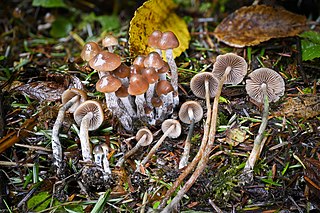
Psilocybe pelliculosa is a species of fungus in the family Hymenogastraceae. The fruit bodies, or mushrooms, have a conical brownish cap up to 2 cm in diameter atop a slender stem up to 8 cm long. It has a white partial veil that does not leave a ring on the stem. American mycologist Alexander H. Smith first described the species in 1937 as a member of the genus known today as Psathyrella; it was transferred to Psilocybe by Rolf Singer in 1958.

Amanita crocea, the saffron ringless amanita, is a species of Amanita widely distributed in Europe.
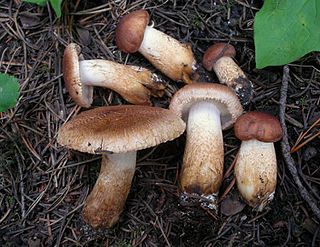
Tricholoma vaccinum, commonly known as the russet scaly tricholoma, the scaly knight, or the fuzztop, is a fungus of the agaric genus Tricholoma. It produces medium-sized fruit bodies (mushrooms) that have a distinctive hairy reddish-brown cap with a shaggy margin when young. The cap, which can reach a diameter of up to 6.5 cm (2.6 in) wide, breaks up into flattened scales in maturity. It has cream-buff to pinkish gills with brown spots. Its fibrous, hollow stipe is white above and reddish brown below, and measures 4 to 7.5 cm long. Although young fruit bodies have a partial veil, it does not leave a ring on the stipe.

Cortinarius camphoratus, commonly known as the goatcheese webcap, is an agaric fungus in the family Cortinariaceae. The fungus is found in Europe and North America, where its fruit bodies (mushrooms) grow on the ground in a mycorrhizal association with spruce and firs in coniferous forests. Mushrooms are characterized by pale blue lilac colors when young, and a strong distinctive odor. Sources disagree as to the edibility of the mushroom, but they are generally not recommended for eating.
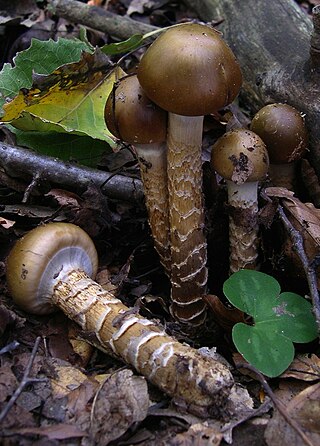
Cortinarius trivialis is a species of inedible fungus in the genus Cortinarius.
